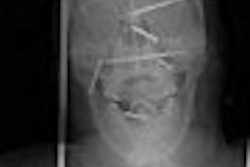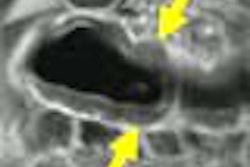Gastroenterologists lack the resources to screen a burgeoning population of eligible fiftysomethings for colorectal cancer, making virtual colonoscopy a logical adjunct, according to Dr. John Bond, chief of gastroenterology at the Minnesota VA Medical Center in Minneapolis. Even if widespread conventional colonoscopy screening were feasible, he said, not all patients would choose it.
"We don't have that capacity, nowhere near it, and I don't think there's any way we're going to get it," Bond said, citing a population-based estimate by Dr. David Rex and Dr. David Lieberman. The researchers calculated that even if three-fourths of the eligible U.S. population of 77 million were to forgo colonoscopy due to noncompliance (43.9%), comorbidities (5%) or previous colorectal cancer screening (25%), an additional 2.6 million colonoscopies would still be needed each year to satisfy screening demand at current population levels (Gastrointestinal Endoscopy, Nov. 2001, Vol. 54:5, pp. 662-667).
Bond, who received a distinguished clinician award from the American Gastroenterological Association in May, has been involved in colorectal cancer screening ever since 1975, when his group participated in the first fecal occult blood trial (New England Journal of Medicine, November 30, 2000, Vol. 343:22, pp. 1603-1607).
At the 2003 International Symposium on Virtual Colonoscopy in Boston, Bond offered a balanced, wide-ranging look at colorectal cancer screening from a gastroenterologist's perspective.
"I don’t think people should get too anxious...in the radiology community about hindrances and barriers and the slowness of how (virtual colonoscopy) technology is evolving," he said. "It’s actually evolving very rapidly since it was introduced... following the same course as virtually every other form of screening, and in fact maybe it’s going a bit faster."
And because VC's core potential lies in widespread population-based screening, pushing for approval to screen small subpopulations of high-risk patients would be counterproductive in the long run, he predicted.
"I would first of all advise staying the course, and I would advise keeping all of the discussions, all of the science, way out into the light where everybody can see it," he said. "That’s where I think the criticisms will be correct and perceptions will constructively change, leading to acceptance of virtual colonoscopy as a screening option."
Toward approval
Virtual colonoscopy has recently been considered, and rejected for the time being, by all of the major bodies evaluating screening procedures in the U.S. The U.S. Preventive Services Task Force (USPSTF), for example, found insufficient evidence that virtual colonoscopy led to improved health outcomes, while the American Cancer Society said that more evidence of improved outcomes was needed.
The expert panels are, understandably, looking for consistent accuracy and widespread availability in the virtual test, Bond said. But he argued that such a standard is unreasonably high considering that VC has already reached or surpassed the accuracy levels of many alternative exams that have been approved, including flexible sigmoidoscopy, fecal occult blood testing, and the double-contrast barium enema.
"The (USPSTF) guidelines state -- and I don’t know if they mean this sincerely -- that when a new test comes along it will be included (in the screening guidelines), but it has to first be shown to be as safe, acceptable, available, and as cost-effective as the method it’s replacing," Bond said.
"I think that’s an overly stringent objective for a new test. I think there are number of new tests that might prove to be more acceptable to patients and not fulfill all of these other criteria," he added. "It may have decreased risks compared to others, and yet still might not fulfill all the other criteria, and I think it still should be considered for acceptance. Certainly virtual colonoscopy falls into that potential category...we started a long time ago worrying only about cancer, so now we’re arguing whether it’ll pick up smaller polyps."
The main reason conventional colonoscopy has been pushed to the forefront is the drastic change in colorectal cancer screening goals in the past five years, Bond said.
"When we started the fecal occult blood trial (in 1975), the main objective was to find early cancers when they could be operated on: Dukes A and B cancers, which, once resected, provided a cure," he said. "What’s much more important today is the focus on finding and resecting the advanced adenoma, and thereby preventing cancer from occurring altogether...and colonoscopy obviously has some advantages in that it is the most accurate way to detect all adenomas probably, but it also allows resection at the time of the examination with a single preparation, a great advantage to many patients."
Conventional colonoscopy also provides fairly consistent diagnostic accuracy, and even an ability to consistently detect flat lesions. Still, he said, the exam is plagued by its relatively high cost, invasiveness that makes it unacceptable and even risky for some patients, a small risk of bowel perforation, and a relatively high failure rate compared to virtual colonoscopy.
"Gastroenterologists prefer direct colonoscopy, although it’s somewhat hypocritical because they know they can’t do (all the screening), and don’t have the resources to do it…and we also know that it’s not being done. Surveys show that low screening rates (remain) in the 20%-30% range at best," Bond said.
In its favor, virtual colonoscopy is less invasive, has a shorter exam time, no need for sedation, and consequently fewer risks. It can examine both sides of the colon wall, evaluate wall thickness, and precisely localize lesions -- a difficult trick to perform in conventional colonoscopy, Bond said. And virtual colonoscopy still works when colonoscopy is incomplete or the distal colon is obstructed.
But VC's accuracy has been less consistent than its conventional counterpart, he said, and VC still requires an uncomfortable bowel prep and colonic distension.
"We’re very concerned about some of the large, flat lesions that have been missed in some of the large (VC) studies, and these are very dangerous lesions," Bond said. "The learning curve, and I don’t think this should be de-emphasized, is something that adds clearly to the cost."
Studies
A few studies, such as the August 2003 Mayo Clinic study, have shown high interobserver variability that warrants explanation, he said. With average sensitivity for polyps 1 cm and larger at 46% (range, 32%-73%), "clearly this would not be the data that would push virtual colonoscopy into the guidelines" of acceptable screening procedures, he said.
"However, we've heard reasons for this," Bond said. "(VC) is such a rapidly moving target that when you include data from many years, you're looking at cases that were done when sensitivity would be lower. That's natural in a long-term study, but it's the biggest study published to date, and I think it needs to be explained" (Gastroenterology, August 2003, Vol. 125:2, pp. 311-319).
As for the multicenter MUSC trial, which also yielded poor results, "quality control between institutions was so poor that I think all you can say out of that study is what VC can (potentially) do, and that is in the data from Wake Forest (University), where they had very high sensitivity," Bond said. "But the other centers clearly were not up to speed. MUSC, I think, is a study that gives virtual colonoscopy a black eye because of the way it's presented and the way it's not explained." (This study was subsequently published in JAMA, April 14, 2004, Vol. 291:14, pp. 1713-1719, 1772-1774.)
On the other hand, he said, some of the larger single-center virtual colonoscopy studies have been quite impressive, yielding sensitivities greater than 90% for the detection of larger polyps.
"(The) Department of Defense study shows what can be done in a low-prevalence group who are average-risk patients for screening," he said. "It is a very remarkable study, and I think when that study's published it's going to strongly push things along. It may mean that there need to be adjustment in how the procedure is done at other institutions, but I think that's what needs to happen.... But it's a very dramatic event...to have those wonderful results from that study. I think one has to try to explain why some of the other studies haven't shown the same thing." (This study was subsequently published in the New England Journal of Medicine, December 4, 2003, Vol.349:23, pp. 2191-2200.)
As for conventional colonoscopy, "we know something about its accuracy from two rather remarkable tandem colonoscopy studies, where patients agreed to have two colonoscopies done back to back by two different examiners," Bond said. In the study by Rex and colleagues, colonoscopy had an 87% sensitivity for the detection of adenomas 6-9 mm, and 94% for adenomas 1 cm and larger (Gastroenterology, January 1997, Vol. 112:1, pp. 24-28).
Compliance
Compliance is the weak link for all colorectal cancer screening efforts, Bond said. Even if the test is perfect, low compliance can render it useless. In the published reports, virtual colonoscopy has compared very well with the conventional exam, he said.
"There have been six reports that I could find, and when they surveyed patients who had both procedures, three preferred virtual colonoscopy, three preferred colonoscopy," he said. "But very interestingly, when they were asked what they would do with their next screening, in five of six of these studies VC was preferred by more patients. So I think there are some very big advantages and opportunities where compliance is concerned for this procedure."
Another problem is that VC is diagnostic only, he said, so in the 20% or so of patients who require colonoscopic follow-up, the bill is for two fairly expensive tests. With computer-aided detection and the economies of scale afforded by large facilities, virtual colonoscopy's cost may remain low enough in the future to be cost-effective, he said.
"I believe very strongly in what Dr. (Seth) Glick has stated -- and not all gastroenterologists accept this notion -- that we don't need to worry about the small adenoma. Small tubular adenomas have almost no clinical significance, certainly not immediately. They also do not predict an increased risk of synchronous or metachronous advanced neoplasia, and I don't think we should worry about them. We should focus on ways to detect the advanced adenoma, most of which are over 1 cm in diameter. This fits in very nicely to the virtual colonoscopy issues."
Therefore, a test that accurately detects large lesions but misses the smaller ones can be very effective, Bond said. There is some concern about the intermediate-sized lesions, 5-9 mm. However, if screening is kept to relatively short intervals (which does raise the cost), virtual colonoscopy could be effective in such a scenario.
Virtual colonoscopy is safe, it is becoming increasing available, and its accuracy for detecting advanced adenomas approaches that of colonoscopy at some centers, Bond concluded, adding that if its practitioners are able to develop more user-friendly prep and distension options, people will be "knocking down the doors" to get it.
"By the way, I always say 'VC,' and I think it’s a mistake to press for calling this 'CTC,' because the public loves the name 'virtual colonoscopy,' and I think that’s one of the great advantages this procedure has," Bond said. "When an article appears in the New York Times or the Washington Post or my newspaper, patients call me up and say 'I want this virtual colonoscopy. I don’t want the old kind you’ve been doing for me, I want this new kind' -- and they just love this idea of a virtual examination."
By Eric BarnesAuntMinnie.com staff writer
July 16, 2004
Related Reading
CPT codes and the politics of virtual colonoscopy, April 30, 2004
Politics matters in the real world of virtual colonoscopy, November 5, 2003
Toward a CRC screening strategy: gastroenterologists take the stage, June 3, 2002
Copyright © 2004 AuntMinnie.com




















